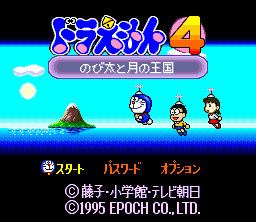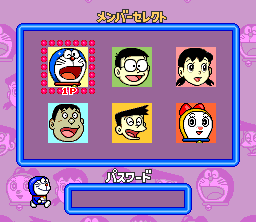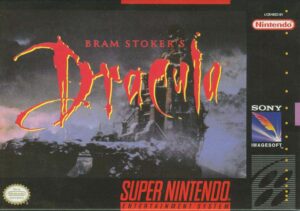Retro Replay Review
Gameplay
Doraemon 4: Nobita to Tsuki no Ōkoku delivers a classic side-scrolling platform experience that will feel instantly familiar to fans of titles like Super Mario World. Players traverse an overworld map laid out like a stylized moon surface, selecting from a roster of six characters—Doraemon, Nobita, Shizuka, Gian, Suneo, and another unlockable friend—before diving into each stage. Each character has unique attributes: Doraemon’s gadgets offer ranged attacks, Nobita relies on agility, and the others specialize in varying degrees of speed, strength, and special tools.
(HEY YOU!! We hope you enjoy! We try not to run ads. So basically, this is a very expensive hobby running this site. Please consider joining us for updates, forums, and more. Network w/ us to make some cash or friends while retro gaming, and you can win some free retro games for posting. Okay, carry on 👍)
Once inside a level, the core mechanics revolve around running, jumping, stomping on enemies’ heads, and utilizing an arsenal of futuristic gadgets to clear obstacles. Standard pickups include energy pellets, time-stopping tokens, and various mech-powered suits that temporarily enhance your abilities. What sets this game apart is the dual-character power-up system: by carrying or riding a second character, you can unlock combined attacks—such as Doraemon’s “Time Hammer” amplified by Nobita’s speed boost—to solve environmental puzzles and defeat tougher foes.
Levels are peppered with hidden rooms, warp tubes, and clever vertical sections that reward exploration. The difficulty curve remains accessible for younger players, with generous checkpoint placement, but later stages introduce more precise platforming challenges and enemy patterns that demand practice. Boss encounters at the end of each world require mastery of character-specific gadgets and quick reaction times, ensuring that seasoned platformer enthusiasts will find enough depth to stay engaged.
Graphics
Visually, Doraemon 4 adheres closely to the beloved manga’s bright and whimsical art style. Sprites are crisp and colorful, with smooth animations that capture Doraemon’s expressive eyes and Nobita’s nervous flailing. Backgrounds shift expertly from verdant Moon Kingdom gardens to crystalline caverns lit by ethereal moonlight, each with multiple parallax layers that give a satisfying sense of depth.
The level design showcases varied biomes: drifting lunar plains studded with crater-like pits, mechanical fortress stages bristling with pistons and conveyor belts, and even a low-gravity zone where jumps arc lazily through a star-studded sky. Enemy designs range from mischievous lunar mice to robotic guardians, each animated in a style that feels true to the franchise’s playful tone. Subtle particle effects—sparkles on collectible Dorayaki, shimmering shields around powered-up characters—add polish without overwhelming the screen.
Performance is rock-solid throughout, with a stable frame rate and minimal slowdowns. The user interface remains unobtrusive, displaying health, gadgets, and time tokens in clean iconography at the top of the screen. Even when multiple characters share the screen in two-player mode, the action stays responsive and readable, making split-second decisions feel fair and manageable.
Story
The narrative kicks off with a serene moment under the moonlight: Doraemon and Nobita gazing at the glowing orb overhead, only to be whisked away by a mysterious beam of light. Soon they discover the Moon Kingdom—once a thriving realm of harmony—now besieged by a dark force that has scattered its inhabitants and drained its luminescent fountains. It’s up to our heroes to uncover the source of this calamity and restore peace.
Story progression is communicated through brief yet charming cutscenes rendered in bright, comic-style panels. Each rescued moon citizen offers a tidbit of lore, from tales of the benevolent lunar queen to rumors of a rogue scientist harnessing forbidden gadgetry. Dialogue remains faithful to the manga’s blend of humor and heart, with Nobita’s trademark clumsiness counterbalanced by Doraemon’s earnest determination.
Between worlds, you’ll encounter mini-quests that expand the narrative: rescuing trapped villagers, retrieving lost artifacts, and even repairing broken time machines that hint at future adventures. Although the overall plot follows a straightforward rescue-and-rebuild structure, these diversions add emotional weight and a sense of discovery that keeps the story feeling fresh throughout the roughly dozen levels.
Overall Experience
Doraemon 4: Nobita to Tsuki no Ōkoku strikes an impressive balance between nostalgia and solid platforming design. Younger players will be drawn to its friendly characters and approachable controls, while longtime fans of Doraemon will appreciate the faithful representation of their favorite robotic cat and his companions. The dual-character power-up mechanic adds a strategic layer that encourages experimentation and cooperative play.
While the game never veers into punishingly difficult territory, it offers enough challenge in its later stages to keep completionists engaged. Secret paths, time-attack modes, and collectible crowns scattered across levels provide plenty of replay value. The colorful graphics and upbeat soundtrack create an inviting atmosphere that seldom grows stale, making it easy to spend hours uncovering every hidden room.
In summary, Doraemon 4 is a delightful homage to classic platformers, wrapped in the charm of one of Japan’s most beloved franchises. Its blend of varied characters, imaginative level design, and lighthearted story makes it a strong recommendation for families, casual gamers, and Doraemon aficionados alike. If you’ve ever dreamed of hopping across lunar landscapes alongside a time-traveling cat, this game is worth a spot on your shelf.
 Retro Replay Retro Replay gaming reviews, news, emulation, geek stuff and more!
Retro Replay Retro Replay gaming reviews, news, emulation, geek stuff and more!









Reviews
There are no reviews yet.